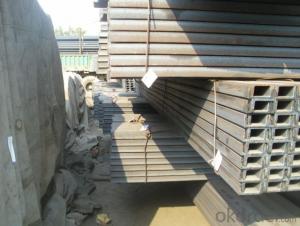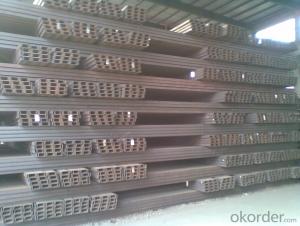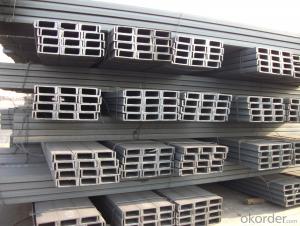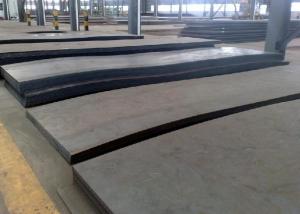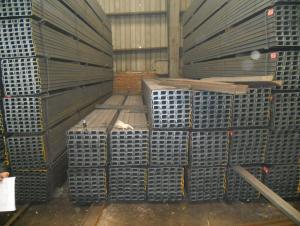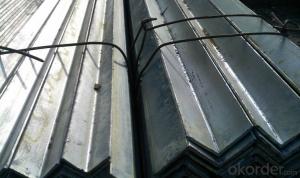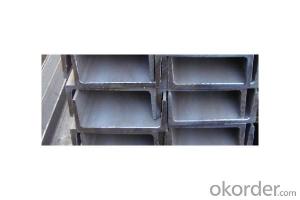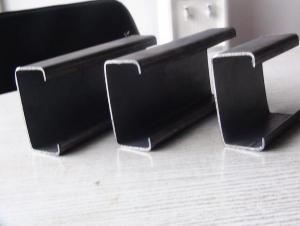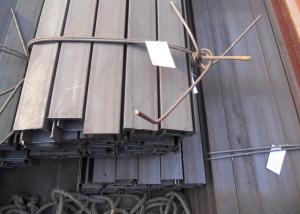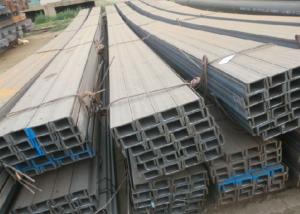Hot Rolled GB Standard Channel Steel
- Loading Port:
- China Main Port
- Payment Terms:
- TT or LC
- Min Order Qty:
- 50 m.t.
- Supply Capability:
- 10000 m.t./month
OKorder Service Pledge
OKorder Financial Service
You Might Also Like
Product Description:
OKorder is offering Hot Rolled GB Standard Channel Steel at great prices with worldwide shipping. Our supplier is a world-class manufacturer of steel, with our products utilized the world over. OKorder annually supplies products to African, South American and Asian markets. We provide quotations within 24 hours of receiving an inquiry and guarantee competitive prices.
Product Applications:
Hot Rolled GB Standard Channel Steel are ideal for structural applications and are widely used in the construction of buildings and bridges, and the manufacturing, petrochemical, and transportation industries.
Product Advantages:
OKorder's Hot Rolled GB Standard Channel Steel are durable, strong, and wide variety of sizes.
Main Product Features:
· Premium quality
· Prompt delivery & seaworthy packing (30 days after receiving deposit)
· Can be recycled and reused
· Mill test certification
· Professional Service
· Competitive pricing
Product Specifications:
Manufacture: Hot rolled
Grade: Q195 – 235
Certificates: ISO, SGS, BV, CIQ
Length: 6m-12m, as per customer request
Packaging: Export packing, nude packing, bundled
| GB STANDARD CHANNEL | ||||||
| SIZE(MM) | h(mm) | b(mm) | s(mm) | t(mm) | kg/m | length |
| 50X37x4.5x7 | 50 | 37 | 4.5 | 7 | 5.438 | 6m,12m |
| 63X40x4.8x7.5 | 63 | 40 | 4.8 | 7.5 | 6.634 | 6m,12m |
| 80x43x5x8 | 80 | 43 | 5 | 8 | 8.045 | 6m,12m |
| 100x48x5.3x8.5 | 100 | 48 | 5.3 | 8.5 | 10.007 | 6m,12m |
| 120x53x5.5x9 | 120 | 53 | 5.5 | 9 | 12.059 | 6m,12m |
| 140x58x6x9.5 | 140 | 58 | 6 | 9.5 | 14.535 | 6m,12m |
| 140x60x8x9.5 | 140 | 60 | 8 | 9.5 | 16.733 | 6m,12m |
| 160x63x6.5x10 | 160 | 63 | 6.5 | 10 | 17.24 | 6m,12m |
| 160x65x8.5x10 | 160 | 65 | 8.5 | 10 | 19.752 | 6m,12m |
| 180x68x7x10.5 | 180 | 68 | 7 | 10.5 | 20.174 | 6m,12m |
| 180x70x9x10.5 | 180 | 70 | 9 | 10.5 | 23 | 6m,12m |
| 200x73x7x11 | 200 | 73 | 7 | 11 | 22.637 | 6m,12m |
| 200x75x9x11 | 200 | 75 | 9 | 11 | 25.777 | 6m,12m |
| 220x77x7x11.5 | 220 | 77 | 7 | 11.5 | 24.999 | 6m,12m |
| 220x79x9x11.5 | 220 | 79 | 9 | 11.5 | 28.453 | 6m,12m |
| 250x78x7x12 | 250 | 78 | 7 | 12 | 27.41 | 6m,12m |
| 250x80x9x12 | 250 | 80 | 9 | 12 | 31.335 | 6m,12m |
| 250x82x11x12 | 250 | 82 | 11 | 12 | 35.26 | 6m,12m |
| 280x82x7.5x12.5 | 280 | 82 | 7.5 | 12.5 | 31.427 | 6m,12m |
| 280x84x9.5x12.5 | 280 | 84 | 9.5 | 12.5 | 35.823 | 6m,12m |
| 280x86x11.5x12.5 | 280 | 86 | 11.5 | 12.5 | 40.219 | 6m,12m |
| 300x85x7.5x13.5 | 300 | 85 | 7.5 | 13.5 | 34.463 | 6m,12m |
| 300x87x9.5x13.5 | 300 | 87 | 9.5 | 13.5 | 39.173 | 6m,12m |
| 300x89x11.5x13.5 | 300 | 89 | 11.5 | 13.5 | 43.883 | 6m,12m |
FAQ:
Q1: Why buy Materials & Equipment from OKorder.com?
A1: All products offered byOKorder.com are carefully selected from China's most reliable manufacturing enterprises. Through its ISO certifications, OKorder.com adheres to the highest standards and a commitment to supply chain safety and customer satisfaction.
Q2: How do we guarantee the quality of our products?
A2: We have established an advanced quality management system which conducts strict quality tests at every step, from raw materials to the final product. At the same time, we provide extensive follow-up service assurances as required.
Q3: How soon can we receive the product after purchase?
A3: Within three days of placing an order, we will arrange production. The normal sizes with the normal grade can be produced within one month. The specific shipping date is dependent upon international and government factors, the delivery to international main port about 45-60days.
Images:
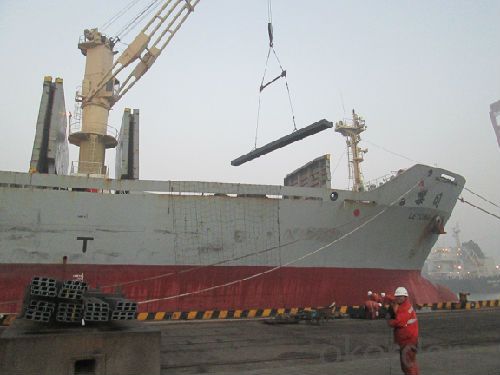

- Q: Can steel channels be used in commercial construction?
- Yes, steel channels can be used in commercial construction. Steel channels are versatile structural components that are commonly used in the construction industry due to their strength, durability, and cost-effectiveness. They are often used as support beams, columns, and framing elements in commercial buildings. Steel channels provide excellent load-bearing capabilities and can withstand heavy loads, making them suitable for use in commercial construction projects where there is a need for robust and reliable structural components. Additionally, steel channels can be easily customized to meet specific design requirements, allowing for flexibility in construction. Overall, steel channels are a popular choice in commercial construction due to their strength, versatility, and suitability for various applications.
- Q: 120*53*5.5 what's the weight of channel steel?
- 120 * 53 * 5.5 12 # 12.06kg/m
- Q: What is the use of angle steel and channel steel?
- Used to make steel structures, such as steel staircases, plant supports, etc..
- Q: How do steel channels perform in coastal or saltwater environments?
- Steel channels typically perform well in coastal or saltwater environments, but their performance can be influenced by a few factors. Firstly, steel channels are generally resistant to corrosion, which makes them suitable for use in saltwater environments. However, it is important to note that the level of resistance can vary depending on the type of steel used. Stainless steel channels, for example, offer excellent corrosion resistance due to the presence of chromium. On the other hand, carbon steel channels may require additional protective coatings to enhance their resistance to corrosion. Secondly, the performance of steel channels in coastal areas can be affected by the presence of salt in the air. Salt particles can settle on the surface of the channels and increase the risk of corrosion. Regular cleaning and maintenance can help minimize the buildup of salt and prevent potential damage. Additionally, the design and installation of steel channels in coastal or saltwater environments should consider the potential for exposure to high humidity, strong winds, and salt spray. Proper sealing, gasketing, and drainage systems should be implemented to prevent the accumulation of water or moisture, which can accelerate the corrosion process. In summary, steel channels generally perform well in coastal or saltwater environments due to their inherent corrosion resistance. However, the specific type of steel used, regular maintenance, and proper design and installation practices are crucial factors that can contribute to their long-term performance in such environments.
- Q: How do steel channels perform in high-temperature environments?
- Due to their inherent strength and durability, steel channels are known to excel in high-temperature settings. Steel possesses properties, like a high melting point and resistance to thermal expansion, that make it a suitable material for elevated temperatures. When exposed to high heat, steel channels can withstand it without significant deformation or loss of structural integrity. One of the primary reasons why steel channels are effective in high-temperature environments is their capacity to maintain their mechanical properties even at elevated temperatures. Steel has a high thermal conductivity, allowing it to efficiently dissipate heat and prevent excessive temperature rise. This quality helps to preserve the structural stability of steel channels when faced with high heat. Furthermore, steel channels are often designed with a high fire resistance rating. This is accomplished by incorporating fire-resistant coatings or fireproofing materials to enhance their performance in extreme temperatures. These measures safeguard the steel channels from the adverse effects of heat, such as weakening or deformation. It is important to recognize that the performance of steel channels in high-temperature environments may be influenced by factors like the specific grade of steel used and the duration of exposure to elevated temperatures. Various grades of steel possess different thermal properties, so it is vital to select the appropriate grade based on the temperature requirements of the particular application. In conclusion, steel channels generally demonstrate excellent performance in high-temperature environments. Their strength, durability, and ability to retain mechanical properties make them well-suited for use in such conditions. However, it is advisable to consult experts or refer to the manufacturer's specifications to ensure that the steel channels are chosen and utilized correctly for optimal performance in high-temperature environments.
- Q: What are the different types of surface treatments for steel channels in marine applications?
- Steel channels used in marine applications can undergo various surface treatments to enhance their durability and corrosion resistance in harsh marine environments. One commonly used treatment is hot-dip galvanizing, where the steel channel is immersed in molten zinc, forming a protective coating that acts as a barrier against corrosion caused by saltwater and other marine elements. Another option is epoxy coating, which involves applying a layer of epoxy paint to the steel channel's surface. This creates a protective barrier that prevents water and oxygen from reaching the steel, minimizing corrosion. Epoxy coatings are particularly effective in marine environments with a high risk of abrasion or impact. Apart from galvanizing and epoxy coating, other surface treatments are available for steel channels in marine applications. These include metalizing, where molten metal is sprayed onto the steel's surface to provide a protective coating, and electroplating, which involves depositing a layer of metal onto the steel using an electric current. There are also specialized marine coatings formulated to withstand the unique challenges of marine environments. These coatings may contain additives or compounds that enhance corrosion resistance and durability. Ultimately, the choice of surface treatment for steel channels in marine applications depends on factors such as the specific environment, required corrosion resistance, and budget. Consulting with a corrosion specialist or engineer is crucial in determining the most suitable treatment for a marine application.
- Q: Are steel channels suitable for earthquake-prone regions?
- Steel channels are indeed suitable for earthquake-prone regions. Steel is known for its high strength and ductility, making it a popular choice for earthquake-resistant construction. Steel channels, in particular, offer several advantages in seismic regions. Firstly, steel channels possess excellent load-bearing capabilities, allowing them to withstand the forces generated during an earthquake. Their shape provides structural rigidity and stability, minimizing the risk of collapse or damage. Steel's inherent flexibility also enables it to absorb and dissipate seismic energy, reducing the impact on the overall structure. Additionally, steel channels can be easily customized and fabricated to meet specific building requirements. This adaptability allows engineers to design structures with appropriate seismic resistance, ensuring that they can withstand the expected ground motion. Steel channels' dimensional accuracy and uniformity also contribute to better construction quality and performance during earthquakes. Another advantage of steel channels is their fire resistance. Unlike other building materials, such as wood or concrete, steel does not burn or contribute to the spread of fire. This characteristic makes steel channels a safer choice for earthquake-prone regions, where fires can often occur due to ruptured gas lines or electrical failures during seismic events. Moreover, steel's durability and resistance to corrosion make it ideal for long-term use in earthquake-prone areas. Steel channels require minimal maintenance and have a longer lifespan compared to other materials, ensuring the continued safety and stability of structures over time. In conclusion, steel channels are highly suitable for earthquake-prone regions due to their strength, ductility, load-bearing capabilities, adaptability, fire resistance, and durability. These qualities make steel channels a reliable choice for constructing earthquake-resistant buildings that can withstand the forces generated by seismic events.
- Q: How do steel channels perform in high-load applications?
- Steel channels perform exceptionally well in high-load applications due to their high strength and load-bearing capabilities. The design of steel channels allows for efficient distribution of weight, making them ideal for supporting heavy loads and withstanding significant stresses. The structural integrity of steel channels ensures that they can handle the demands of high-load applications without compromising safety or performance. Steel channels are commonly used in construction, automotive, and industrial sectors where there is a need to support heavy equipment, structures, or machinery. Their robustness and durability make them reliable and long-lasting, even under extreme conditions. Additionally, steel channels have excellent resistance to bending, twisting, and warping, making them suitable for withstanding dynamic loads and vibrations. Another advantage of steel channels in high-load applications is their versatility. They come in various sizes, shapes, and thicknesses, allowing engineers to select the most suitable channel for a specific application. This flexibility in design ensures an optimal fit for different load requirements, giving engineers the ability to optimize the load-bearing capacity while minimizing weight and material costs. Furthermore, steel channels have good corrosion resistance, especially when coated with protective treatments or finishes. This enables them to withstand harsh environmental conditions and maintain their performance over time. Additionally, steel channels can be easily welded, bolted, or fastened together, providing flexibility in construction and allowing for easy customization or modification as needed. In summary, steel channels are highly reliable and efficient in high-load applications. Their strong and durable nature, along with their versatility and resistance to bending and corrosion, make them an excellent choice for supporting heavy loads in various industries.
- Q: How are steel channels classified based on their shape?
- There are three primary classifications for steel channels, which are determined by their shape: C channels, U channels, and miscellaneous channels. C channels, also known as C-shaped channels or channels, have a distinct shape that resembles the letter "C". They consist of a flat vertical back and two horizontal flanges that extend outward from the back. C channels are widely utilized in construction and structural applications due to their ability to provide excellent load-bearing support. U channels, alternatively referred to as U-shaped channels or U-channels, possess a cross-section in the shape of a U, with two vertical sides and a horizontal base. The vertical sides are known as flanges, while the horizontal base is called the web. U channels are commonly employed in manufacturing and fabrication processes as they offer stability and strength to various structures. Miscellaneous channels encompass all other steel channel shapes that do not fit into the C or U channel categories. These channels can come in a variety of shapes and sizes, such as tapered flanges, uneven sides, or unique profiles. Miscellaneous channels find their purpose in specialized applications where specific design requirements must be met. To summarize, steel channels are classified into C channels, U channels, and miscellaneous channels based on their shape. Each of these categories serves different purposes in the construction, manufacturing, and other relevant industries.
- Q: Channel 10, 6 meters long, two ends fixed, how much weight can the middle bear?
- It's important to see where you've used it. If you allow it to bend, you'll have to bear a lot of weight, but vice versa
Send your message to us
Hot Rolled GB Standard Channel Steel
- Loading Port:
- China Main Port
- Payment Terms:
- TT or LC
- Min Order Qty:
- 50 m.t.
- Supply Capability:
- 10000 m.t./month
OKorder Service Pledge
OKorder Financial Service
Similar products
Hot products
Hot Searches
Related keywords
